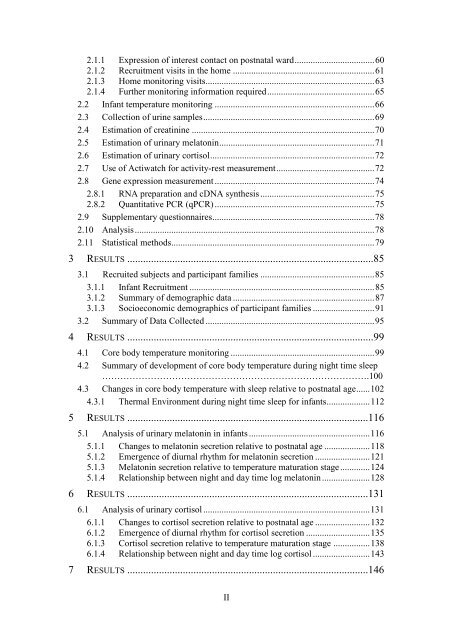The Development of Circadian Rhythms in Human Infants
The Development of Circadian Rhythms in Human Infants
The Development of Circadian Rhythms in Human Infants
You also want an ePaper? Increase the reach of your titles
YUMPU automatically turns print PDFs into web optimized ePapers that Google loves.
2.1.1 Expression <strong>of</strong> <strong>in</strong>terest contact on postnatal ward ................................... 60<br />
2.1.2 Recruitment visits <strong>in</strong> the home .............................................................. 61<br />
2.1.3 Home monitor<strong>in</strong>g visits .......................................................................... 63<br />
2.1.4 Further monitor<strong>in</strong>g <strong>in</strong>formation required ............................................... 65<br />
2.2 Infant temperature monitor<strong>in</strong>g ...................................................................... 66<br />
2.3 Collection <strong>of</strong> ur<strong>in</strong>e samples ........................................................................... 69<br />
2.4 Estimation <strong>of</strong> creat<strong>in</strong><strong>in</strong>e ................................................................................ 70<br />
2.5 Estimation <strong>of</strong> ur<strong>in</strong>ary melaton<strong>in</strong> .................................................................... 71<br />
2.6 Estimation <strong>of</strong> ur<strong>in</strong>ary cortisol ........................................................................ 72<br />
2.7 Use <strong>of</strong> Actiwatch for activity-rest measurement ........................................... 72<br />
2.8 Gene expression measurement ...................................................................... 74<br />
2.8.1 RNA preparation and cDNA synthesis .................................................. 75<br />
2.8.2 Quantitative PCR (qPCR) ...................................................................... 75<br />
2.9 Supplementary questionnaires ....................................................................... 78<br />
2.10 Analysis ......................................................................................................... 78<br />
2.11 Statistical methods ......................................................................................... 79<br />
3 RESULTS .............................................................................................85<br />
3.1 Recruited subjects and participant families .................................................. 85<br />
3.1.1 Infant Recruitment ................................................................................. 85<br />
3.1.2 Summary <strong>of</strong> demographic data .............................................................. 87<br />
3.1.3 Socioeconomic demographics <strong>of</strong> participant families ........................... 91<br />
3.2 Summary <strong>of</strong> Data Collected .......................................................................... 95<br />
4 RESULTS .............................................................................................99<br />
4.1 Core body temperature monitor<strong>in</strong>g ............................................................... 99<br />
4.2 Summary <strong>of</strong> development <strong>of</strong> core body temperature dur<strong>in</strong>g night time sleep<br />
…………………………………………………………………………….100<br />
4.3 Changes <strong>in</strong> core body temperature with sleep relative to postnatal age ...... 102<br />
4.3.1 <strong>The</strong>rmal Environment dur<strong>in</strong>g night time sleep for <strong>in</strong>fants ................... 112<br />
5 RESULTS ...........................................................................................116<br />
5.1 Analysis <strong>of</strong> ur<strong>in</strong>ary melaton<strong>in</strong> <strong>in</strong> <strong>in</strong>fants ..................................................... 116<br />
5.1.1 Changes to melaton<strong>in</strong> secretion relative to postnatal age .................... 118<br />
5.1.2 Emergence <strong>of</strong> diurnal rhythm for melaton<strong>in</strong> secretion ........................ 121<br />
5.1.3 Melaton<strong>in</strong> secretion relative to temperature maturation stage ............. 124<br />
5.1.4 Relationship between night and day time log melaton<strong>in</strong> ..................... 128<br />
6 RESULTS ...........................................................................................131<br />
6.1 Analysis <strong>of</strong> ur<strong>in</strong>ary cortisol ......................................................................... 131<br />
6.1.1 Changes to cortisol secretion relative to postnatal age ........................ 132<br />
6.1.2 Emergence <strong>of</strong> diurnal rhythm for cortisol secretion ............................ 135<br />
6.1.3 Cortisol secretion relative to temperature maturation stage ................ 138<br />
6.1.4 Relationship between night and day time log cortisol ......................... 143<br />
7 RESULTS ...........................................................................................146<br />
II














